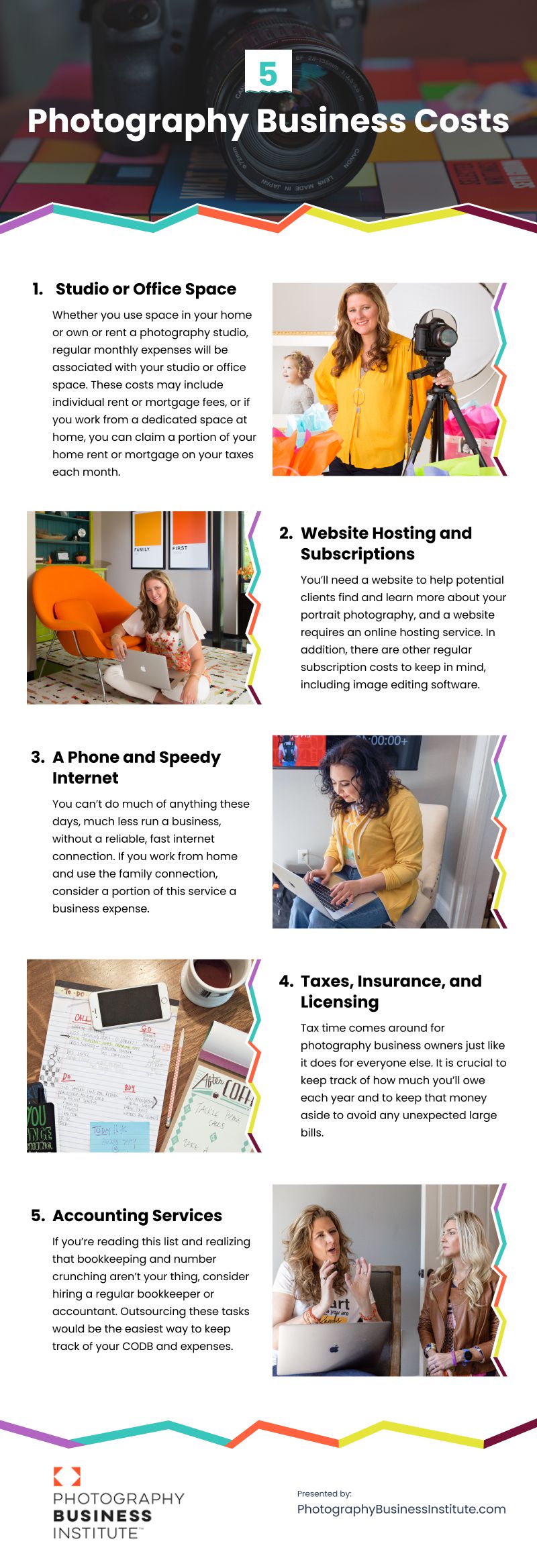While a career in photography will let you showcase your skills and creativity, there are also many, often less glamorous, things to consider when starting a photography business. Financial planning is crucial for any business venture. You must know and budget for all the costs of getting your company off the ground.
Knowing your company’s expenses is a significant factor in photography business pricing. Before setting pricing for portrait sessions, prints, and other products, you must consider all the business costs. Let’s break down what you need to know to make it work.
What Is the Cost of Doing Business?
The cost of doing business (CODB) includes all of a business’s expenses. Knowing your CODB will help you understand how much money you must bring each month to make a profit. This knowledge is essential whether your business is a part-time side hustle or a full-time career. While running numbers may not be the most fun part of building a photography business, it is a crucial skill to learn.
Fixed Vs. Variable Costs
Like every other business, photographers must keep track of fixed and variable costs. Fixed costs are regular monthly or annual expenses invaluable to running your business. These include the mortgage or rent on a studio space, internet service, business insurance, and more. Variable costs will fluctuate more, with one-off or infrequent expenses coming up from time to time. These costs can include things such as camera and equipment purchases, licensing fees, travel expenses, etc.
Photography Business Fixed Costs
1. Studio or Office Space
Whether you use space in your home or own or rent a photography studio, regular monthly expenses will be associated with your studio or office space. These costs may include individual rent or mortgage fees, or if you work from a dedicated space at home, you can claim a portion of your home rent or mortgage on your taxes each month. The rules on this vary by state and country, so be sure to consult with a tax professional on what exactly can be claimed and deducted.
2. Website Hosting and Subscriptions
You’ll need a website to help potential clients find and learn more about your portrait photography, and a website requires an online hosting service. In addition, there are other regular subscription costs to keep in mind, including image editing software.
3. A Phone and Speedy Internet
You can’t do much of anything these days, much less run a business, without a reliable, fast internet connection. If you work from home and use the family connection, consider a portion of this service a business expense. The same thing applies to your cell phone. If you do not have a separate business phone, you may be able to deduct a portion of your monthly phone bill on your taxes if it is used for your business.
4. Taxes, Insurance, and Licensing
Tax time comes around for photography business owners just like it does for everyone else. It is crucial to keep track of how much you’ll owe each year and to keep that money aside to avoid any unexpected large bills. Other necessary regular expenses that are often overlooked when photographers are just starting are business liability insurance, equipment insurance and business licensing fees. Accounting for these legal costs will help keep your business safe and protected.
5. Accounting Services
If you’re reading this list and realizing that bookkeeping and number crunching aren’t your thing, consider hiring a regular bookkeeper or accountant. Outsourcing these tasks would be the easiest way to keep track of your CODB and expenses.
Photography Business Variable Costs
1. Cameras and Photography Equipment
New camera and equipment purchases will be a major variable expense when you’re just starting out. However, it’s important to also remember the costs associated with repairs, replacements and maintenance later.
2. Marketing Costs
It is important to attract new clients to run a successful photography business. Word-of-mouth advertising is free, but you might incur a small cost by wowing your clients with a handwritten note or a gift. Additionally, marketing and promotion costs can include printing and mailing marketing pieces, donations to silent auctions and charity events, displays in local businesses and more.
3. Further Education
Regardless of where you’re at in your photography career, there is always something more to learn. Whether you invest in a photography business coach or sign up for creative workshops, there are plenty of opportunities to further your photography and business education.
4. Outsourcing and Employees
As your business begins to grow, you may need to outsource certain tasks or hire extra help. This may mean hiring an assistant, image editor, administrative assistant, social media manager or other part-time contractors.
Owning a portrait photography business means balancing creative tasks with business strategy. While this list doesn’t cover all the costs associated with starting and running a photography business, it should give you an idea of some of the major expenses you need to consider. It is vital to have a realistic understanding of the CODB when pricing your services and determining how much money you’ll need to make annually.
If financial planning feels overwhelming, consider a photography coach or mentor. They can help you develop a solid plan and gain an in-depth understanding of the costs of running a photography business, freeing you to focus on your creative skills and techniques.
Video
Infographic
Financial planning is vital for any business. Knowing and budgeting for your costs is crucial when launching a photography venture, as it affects pricing. Continue reading to learn more about the fixed costs of running a photography business.










